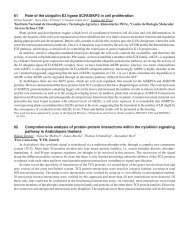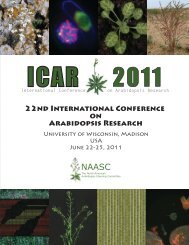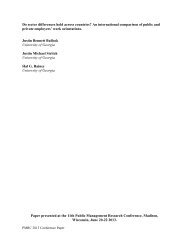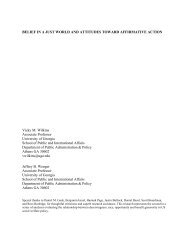- Page 1 and 2: Aging, Metabolism, Stress, Pathogen
- Page 3 and 4: Aging, Metabolism, Stress, Pathogen
- Page 5 and 6: Aging, Metabolism, Stress, Pathogen
- Page 7 and 8: Aging, Metabolism, Stress, Pathogen
- Page 9 and 10: Aging, Metabolism, Stress, Pathogen
- Page 11 and 12: Aging, Metabolism, Stress, Pathogen
- Page 13 and 14: Aging, Metabolism, Stress, Pathogen
- Page 15 and 16: Aging, Metabolism, Stress, Pathogen
- Page 17 and 18: Aging, Metabolism, Stress, Pathogen
- Page 19 and 20: Aging, Metabolism, Stress, Pathogen
- Page 21 and 22: Aging, Metabolism, Stress, Pathogen
- Page 23 and 24: Contact: ewbank@ciml.univ-mrs.fr La
- Page 25 and 26: Contact: kjdumas@umich.edu Lab: Hu
- Page 27 and 28: Contact: ryan.baugh@duke.edu Lab: B
- Page 29 and 30: Contact: xguo@bio.tamu.edu Lab: Gar
- Page 31 and 32: Contact: franzcj@gmail.com Lab: Wan
- Page 33 and 34: Contact: keith.blackwell@joslin.har
- Page 35 and 36: Contact: lapierre@burnham.org Lab:
- Page 37 and 38: Contact: nils.f@bmb.sdu.dk Lab: Fæ
- Page 39 and 40: Contact: kaveh.ashrafi@ucsf.edu Lab
- Page 41 and 42: Contact: emilie.demoinet@mcgill.ca
- Page 43 and 44: Contact: dpark@cmmt.ubc.ca Lab: Tau
- Page 45 and 46: Contact: jmelo@molbio.mgh.harvard.e
- Page 47 and 48: Contact: apasquinelli@ucsd.edu Lab:
- Page 49: Contact: yutao.chen@duke.edu Lab: B
- Page 53 and 54: Contact: felix@biologie.ens.fr Lab:
- Page 55 and 56: Contact: sszumows@ucsd.edu Lab: Tro
- Page 57 and 58: Contact: jsimske@metrohealth.org La
- Page 59 and 60: Contact: stroustr@fas.harvard.edu L
- Page 61 and 62: Contact: haynesc@mskcc.org Lab: Hay
- Page 63 and 64: Contact: pathu@umich.edu Lab: Hu Ag
- Page 65 and 66: Contact: sunc@morpheus.wustl.edu La
- Page 67 and 68: Contact: abigail.cabunoc@oicr.on.ca
- Page 69 and 70: Contact: rtaylor@salk.edu Lab: Dill
- Page 71 and 72: Contact: wmadaki@gmail.com Lab: Suz
- Page 73 and 74: Aging, Metabolism, Stress, Pathogen
- Page 75 and 76: Contact: atchen@umich.edu Lab: Hu A
- Page 77 and 78: Contact: kjdumas@umich.edu Lab: Hu
- Page 79 and 80: Aging, Metabolism, Stress, Pathogen
- Page 81 and 82: Aging, Metabolism, Stress, Pathogen
- Page 83 and 84: Aging, Metabolism, Stress, Pathogen
- Page 85 and 86: Aging, Metabolism, Stress, Pathogen
- Page 87 and 88: Aging, Metabolism, Stress, Pathogen
- Page 89 and 90: Aging, Metabolism, Stress, Pathogen
- Page 91 and 92: Aging, Metabolism, Stress, Pathogen
- Page 93 and 94: Aging, Metabolism, Stress, Pathogen
- Page 95 and 96: Aging, Metabolism, Stress, Pathogen
- Page 97 and 98: Aging, Metabolism, Stress, Pathogen
- Page 99 and 100: Aging, Metabolism, Stress, Pathogen
- Page 101 and 102:
Contact: cbrey@marywood.edu Lab: Ha
- Page 103 and 104:
Aging, Metabolism, Stress, Pathogen
- Page 105 and 106:
Contact: nharriso@scripps.edu Lab:
- Page 107 and 108:
Aging, Metabolism, Stress, Pathogen
- Page 109 and 110:
Aging, Metabolism, Stress, Pathogen
- Page 111 and 112:
Aging, Metabolism, Stress, Pathogen
- Page 113 and 114:
Aging, Metabolism, Stress, Pathogen
- Page 115 and 116:
Aging, Metabolism, Stress, Pathogen
- Page 117 and 118:
Aging, Metabolism, Stress, Pathogen
- Page 119 and 120:
Aging, Metabolism, Stress, Pathogen
- Page 121 and 122:
Aging, Metabolism, Stress, Pathogen
- Page 123 and 124:
Aging, Metabolism, Stress, Pathogen
- Page 125 and 126:
Aging, Metabolism, Stress, Pathogen
- Page 127 and 128:
Aging, Metabolism, Stress, Pathogen
- Page 129 and 130:
Aging, Metabolism, Stress, Pathogen
- Page 131 and 132:
Aging, Metabolism, Stress, Pathogen
- Page 133 and 134:
Aging, Metabolism, Stress, Pathogen
- Page 135 and 136:
Aging, Metabolism, Stress, Pathogen
- Page 137 and 138:
Contact: jrice@bmcc.cuny.edu Lab: S
- Page 139 and 140:
Aging, Metabolism, Stress, Pathogen
- Page 141 and 142:
Aging, Metabolism, Stress, Pathogen
- Page 143 and 144:
Aging, Metabolism, Stress, Pathogen
- Page 145 and 146:
Aging, Metabolism, Stress, Pathogen
- Page 147 and 148:
Aging, Metabolism, Stress, Pathogen
- Page 149 and 150:
Aging, Metabolism, Stress, Pathogen
- Page 151 and 152:
Aging, Metabolism, Stress, Pathogen
- Page 153 and 154:
Aging, Metabolism, Stress, Pathogen
- Page 155 and 156:
Aging, Metabolism, Stress, Pathogen
- Page 157 and 158:
Aging, Metabolism, Stress, Pathogen
- Page 159 and 160:
Contact: cschen@mail.ncku.edu.tw La
- Page 161 and 162:
Aging, Metabolism, Stress, Pathogen
- Page 163 and 164:
Aging, Metabolism, Stress, Pathogen
- Page 165 and 166:
Aging, Metabolism, Stress, Pathogen
- Page 167 and 168:
Contact: jmiskowski@uwlax.edu Lab:
- Page 169 and 170:
Aging, Metabolism, Stress, Pathogen
- Page 171 and 172:
Aging, Metabolism, Stress, Pathogen
- Page 173 and 174:
Contact: amirsa@caltech.edu Lab: St
- Page 175 and 176:
Aging, Metabolism, Stress, Pathogen
- Page 177 and 178:
Aging, Metabolism, Stress, Pathogen
- Page 179 and 180:
Aging, Metabolism, Stress, Pathogen
- Page 181 and 182:
Contact: jordan.ward@ucsf.edu Lab:
- Page 183 and 184:
Aging, Metabolism, Stress, Pathogen
- Page 185 and 186:
Aging, Metabolism, Stress, Pathogen
- Page 187 and 188:
Aging, Metabolism, Stress, Pathogen
- Page 189 and 190:
Aging, Metabolism, Stress, Pathogen
- Page 191 and 192:
Aging, Metabolism, Stress, Pathogen
- Page 193 and 194:
Contact: mmondoux@holycross.edu Lab
- Page 195 and 196:
A Aebi, Markus.....................
- Page 197 and 198:
Goldstein, Leonard D...............
- Page 199 and 200:
Morimoto, Richard I ...............
- Page 201 and 202:
Veal, Elizabeth A .................
- Page 203 and 204:
Phone • N W Studio B E Studio A E

















